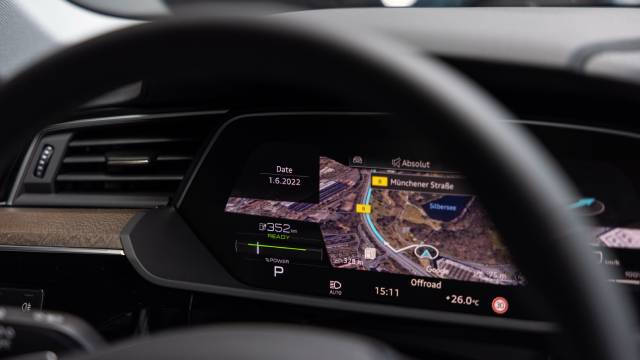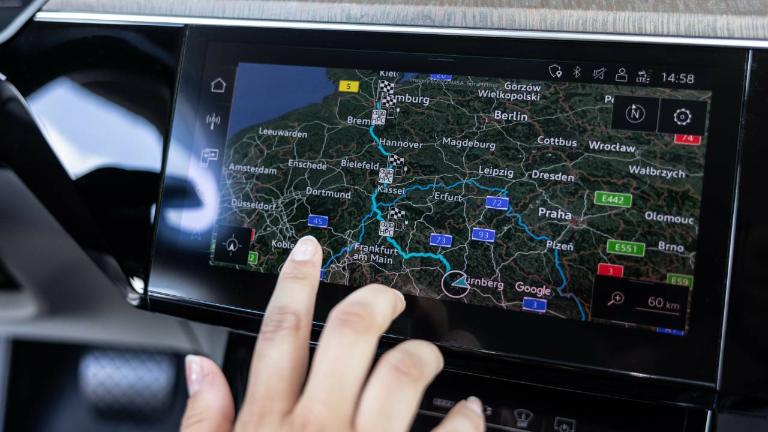Audi, a precise calculation of remaining range for optimal planning
Audi provides precise indications of the remaining range by analysing route topography, traffic and consumption data and updating the information in real time.
When driving an electric vehicle, having reliable indications of range is a prerequisite for planning one's mobility needs, regardless of destination and route. Consumption and range data from type approval cycles only represent general information: in practice, range is impacted by many parameters. There are external factors such as route characteristics, traffic and outside temperature, but also the individual driving style and the use of comfort features (such as air conditioning) that require electricity. The Audi e-tron's range calculation takes all relevant parameters into account and provides a realistic picture, showing it on the display; in parallel, the route planner includes the necessary charging stops on the route and can be set either from inside the car or before departure via the myAudi app.
Reliable and accurate
"We want to always show our customers an honest indication of the remaining range that they can easily reach with their own driving style. That's why our smart calculation system takes all eventualities into account - be it summer time, summer traffic or winter weather with its associated heating requirements. Reliability and honesty in terms of range are important elements to dispel reservations about e-mobility and permanently relieve range anxiety. This is the approach followed by our remaining range display, so that drivers can be sure they will reach their destination as planned,” explains Christiane Zorn, Head of Audi Product Marketing.

Dynamic or predictive
Audi e-tron models give drivers the choice between two different options to calculate the range: one with the route planner integrated in the Audi MMI (Multi Media Interface) infotainment system, one without. Without the support of the navigator and route planner, the calculation of the remaining range is based on recent consumption values and thus also on the driving style. Isolated energy-demanding factors, such as overtaking, are instead reliably averaged, ensuring a realistic calculation. The calculation of the remaining range also takes into account the demands of thermal management (heating or air conditioning) and the use of additional comfort features such as seat or steering wheel heating. Finally, the selected driving mode, individual car configuration, load and weather conditions are also taken into account. In this way, the range display represents the most recent consumption data and projects them into the future, without additional data from the route planner.

The importance of the route
In order to calculate the range based on the route, recent consumption data is supplemented with additional data from the route planner. This means that the system takes into account the topography of the planned route and divides it into sections for calculation purposes: each stage of the route is then assigned an expected driving speed and the division into small sections facilitates a highly precise calculation. Other parameters considered are the presence of motorway sections and traffic forecasts. The latter, together with speed limits and road types, influence the calculation in real time. This type of calculation is capable of differentiating whether the driver is driving relaxed on country roads at an average speed of 80 km/h and with summer temperatures, or travelling on a motorway in the middle of winter with the heater working overtime.
Dynamic processing
The dynamic calculation of the remaining range takes into account both vehicle-related and external factors - such as real-time traffic - which are collected continuously and added directly into the calculation. Vehicle-related factors, on the other hand, concern changes in the use of comfort features or driving behaviour. If the heating or air conditioning is switched on or off, the remaining range is immediately recalculated and the new value shown on the display. This allows drivers to see in real time how their behaviour affects the range. Data processing, thanks to the computing power installed on board the Audi e-tron - which eliminates the need for a connection to an external data processor - takes only a few milliseconds. The system is autonomous and does not need a mobile network.

Journey planning
The route planner function of the Audi e-tron was first introduced in all electric models with the MIB 2+ infotainment system. In 2020, with the roll out of the third generation MIB 3, more extensive planning functions with ten times more computing power have been implemented. Its usefulness is further increased by a new algorithm that includes daily updated data on charging points and alternative routes, both optimised for the requirements of e-vehicles, to provide even more support to drivers. This data includes detailed information such as payment and authentication options, but also on the operator and any access restrictions.
Route planner
As part of route planning, Audi makes sure that there is always a reliable basis for information about charging points. The route planner only suggests the charging stops necessary to reach the destination safely, with the purpose of ensuring the shortest possible journey time. If the route or consumption changes, either due to unforeseen traffic or due to a change in comfort features, charging stops are also adjusted if necessary. A lot also depends on the available infrastructure: two short stops for high-power charging may be preferable to one long stop at a low-power charging station. Therefore, alternative routes including better charging infrastructure are also considered in the calculation of the total travel time. Basically the Audi e-tron route planner favors fast charging stations.
Source: AUDI AG
VGI | Responsible OU: VP | Creation date: article date | Class 9.1
